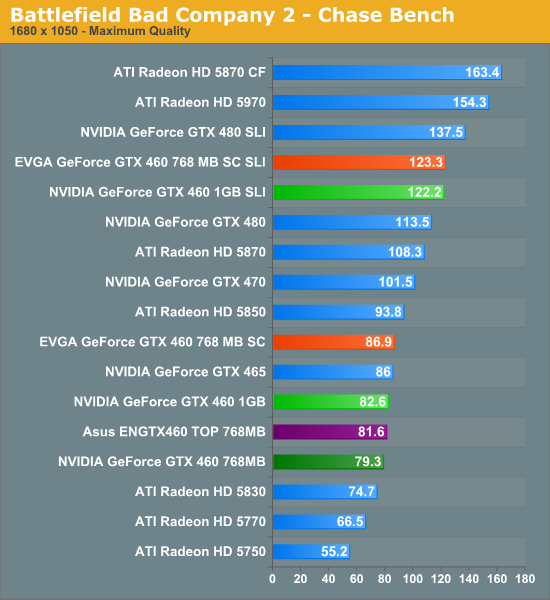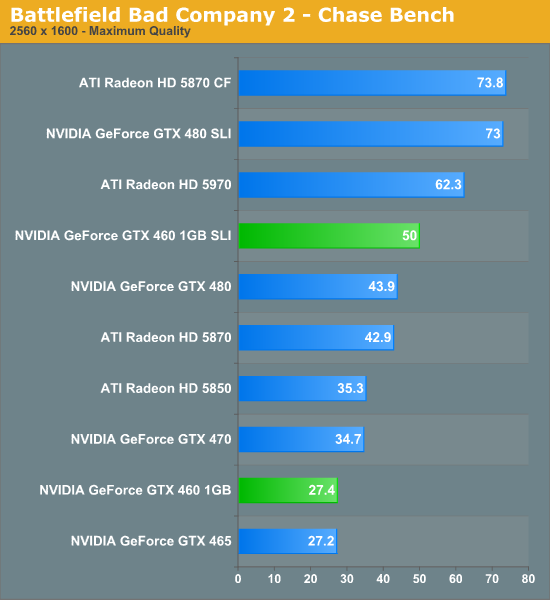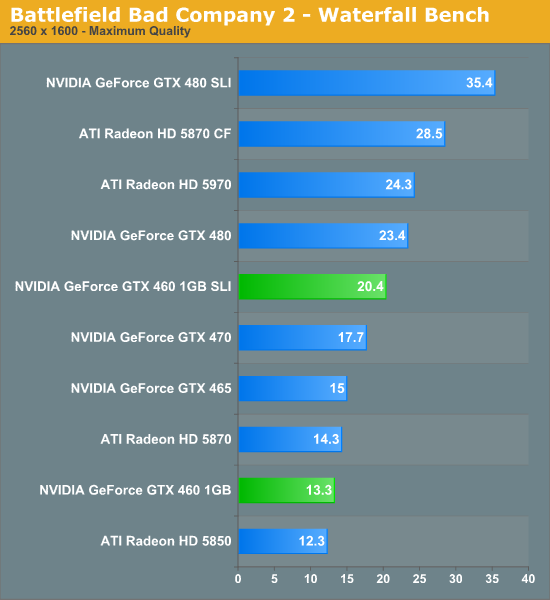NVIDIA’s GeForce GTX 460: The $200 King
by Ryan Smith on July 11, 2010 11:54 PM EST- Posted in
- GPUs
- GeForce GTX 400
- GeForce GTX 460
- NVIDIA
Battlefield: Bad Company 2
The latest game in the Battlefield series - Bad Company 2 - is another one of our new DX11 games and has been a smash hit at retail. It’s also surprisingly hard on our GPUs, enough so that we can say we found something that’s more demanding than Crysis. As BC2 doesn’t have a built-in benchmark or recording mode, here we take a FRAPS run of the jeep chase in the first act, which as an on-rails portion of the game provides very consistent results and a spectacle of explosions, trees, and more.



Bad Company 2 is a game where at the launch of the GTX 400 series NVIDIA started well behind before finally catching up with the 256-series driver release. It’s still not a game where they shine in, but it does at least keep them competitive. Here the Radeon 5830 basically ties the 768MB GTX 460, while the extra RAM/L2/ROP of the 1GB card gives it a 7% lead. At that delta, overclocking the GTX 460 can close the gap. Meanwhile the GTX 465 and 1GB GTX 460 return to trading blows, with the GTX 460 edging out the GTX 465.

As for our worst case scenario Bad Company 2 waterfall benchmark, we get an interesting shakeup. As has been the case with the other GTX 400 series cards, the 1GB GTX 460 does better here than it does on the Chase benchmark, putting it between the Radeon 5850 and 5870. However in turn the GTX 465 edges the GTX 460 out for a slight lead, in which case we’re probably shader bound.










93 Comments
View All Comments
Howard - Monday, July 12, 2010 - link
What?Zok - Monday, July 12, 2010 - link
Excellent writeup! I really enjoyed you going into depth on the architectural changes. I couldn't agree more that it's superb to see NVIDIA get back into the efficiency game - whether it be performance/price or performance/watt (and, by extension, temperature). Here's to hoping that AMD was sitting on something to combat this!P.S. Small typo: For everything but the high-end, this year is a feature yet and not a performance year.
thekimbobjones - Monday, July 12, 2010 - link
Let the price war begin.homerdog - Monday, July 12, 2010 - link
"Here we use the DX11 renderer and turn on self shadowing ambient occlusion (SSAO) to its highest setting, which uses a DX11 ComputeShader."I don't think that's what SSAO stands for. Sorry for the nitpick.
chizow - Monday, July 12, 2010 - link
Yeah I believe the proper term is Screen Space Ambient Occlusion but self shadowing is how its often explained to give an idea of what it is.gentlearc - Monday, July 12, 2010 - link
The graphs shown are leaving out too many new derivatives of cards, making is good for contrasting results, but poor for consistent data comparison. Conveniently left out are many cards in one graph that are in another. I'm disappointed in your presentation and find you've concentrated too much on the presentation of your article.Ryan Smith - Monday, July 12, 2010 - link
Out of curiosity, what's not in our graphs that you'd like to see? At 2560 we run a limited number of cards because most cards are too slow to post a passable framerate, otherwise at 1920 and 1680 we have the complete 5700/5800/5900 series, GTX 400 series, GTX 200 series, and Radeon 4800 series, along with a 3870 and 8800GT. Is there something else you would like?SpaceRanger - Monday, July 12, 2010 - link
What I'd like to see is the ATI card that is in direct competition with this highlighted as well. Having to search for the 5830 or 5850 out of all those bars turned me off.estaffer - Monday, July 12, 2010 - link
need some cheese with your whine?SpaceRanger - Monday, July 12, 2010 - link
Sure.. a good Gruyère please...